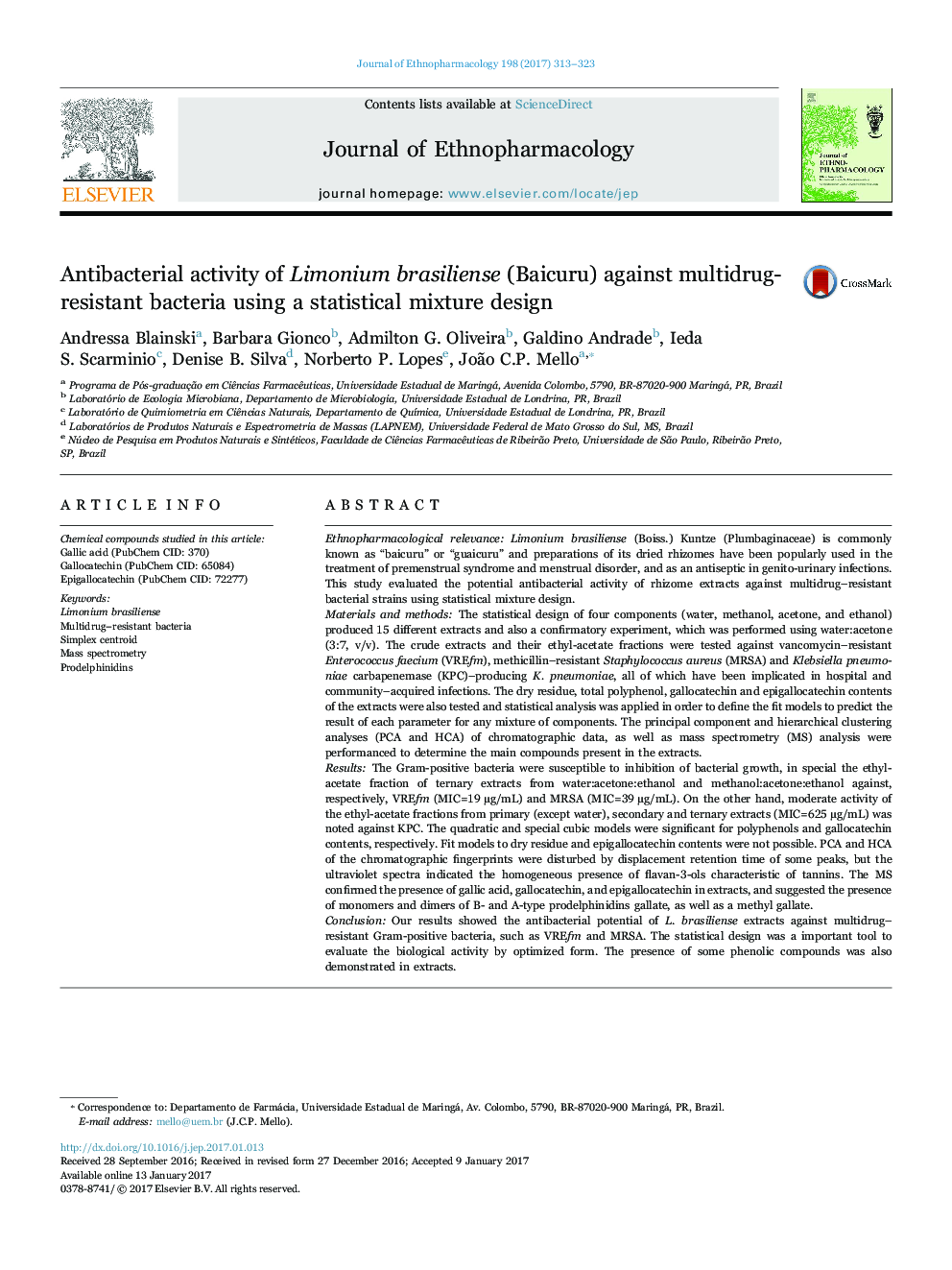| کد مقاله | کد نشریه | سال انتشار | مقاله انگلیسی | نسخه تمام متن |
|---|---|---|---|---|
| 5556336 | 1560364 | 2017 | 11 صفحه PDF | دانلود رایگان |

Ethnopharmacological relevanceLimonium brasiliense (Boiss.) Kuntze (Plumbaginaceae) is commonly known as “baicuru” or “guaicuru” and preparations of its dried rhizomes have been popularly used in the treatment of premenstrual syndrome and menstrual disorder, and as an antiseptic in genito-urinary infections. This study evaluated the potential antibacterial activity of rhizome extracts against multidrug-resistant bacterial strains using statistical mixture design.Materials and methodsThe statistical design of four components (water, methanol, acetone, and ethanol) produced 15 different extracts and also a confirmatory experiment, which was performed using water:acetone (3:7, v/v). The crude extracts and their ethyl-acetate fractions were tested against vancomycin-resistant Enterococcus faecium (VREfm), methicillin-resistant Staphylococcus aureus (MRSA) and Klebsiella pneumoniae carbapenemase (KPC)-producing K. pneumoniae, all of which have been implicated in hospital and community-acquired infections. The dry residue, total polyphenol, gallocatechin and epigallocatechin contents of the extracts were also tested and statistical analysis was applied in order to define the fit models to predict the result of each parameter for any mixture of components. The principal component and hierarchical clustering analyses (PCA and HCA) of chromatographic data, as well as mass spectrometry (MS) analysis were performanced to determine the main compounds present in the extracts.ResultsThe Gram-positive bacteria were susceptible to inhibition of bacterial growth, in special the ethyl-acetate fraction of ternary extracts from water:acetone:ethanol and methanol:acetone:ethanol against, respectively, VREfm (MIC=19 µg/mL) and MRSA (MIC=39 µg/mL). On the other hand, moderate activity of the ethyl-acetate fractions from primary (except water), secondary and ternary extracts (MIC=625 µg/mL) was noted against KPC. The quadratic and special cubic models were significant for polyphenols and gallocatechin contents, respectively. Fit models to dry residue and epigallocatechin contents were not possible. PCA and HCA of the chromatographic fingerprints were disturbed by displacement retention time of some peaks, but the ultraviolet spectra indicated the homogeneous presence of flavan-3-ols characteristic of tannins. The MS confirmed the presence of gallic acid, gallocatechin, and epigallocatechin in extracts, and suggested the presence of monomers and dimers of B- and A-type prodelphinidins gallate, as well as a methyl gallate.ConclusionOur results showed the antibacterial potential of L. brasiliense extracts against multidrug-resistant Gram-positive bacteria, such as VREfm and MRSA. The statistical design was a important tool to evaluate the biological activity by optimized form. The presence of some phenolic compounds was also demonstrated in extracts.
200
Journal: Journal of Ethnopharmacology - Volume 198, 23 February 2017, Pages 313-323